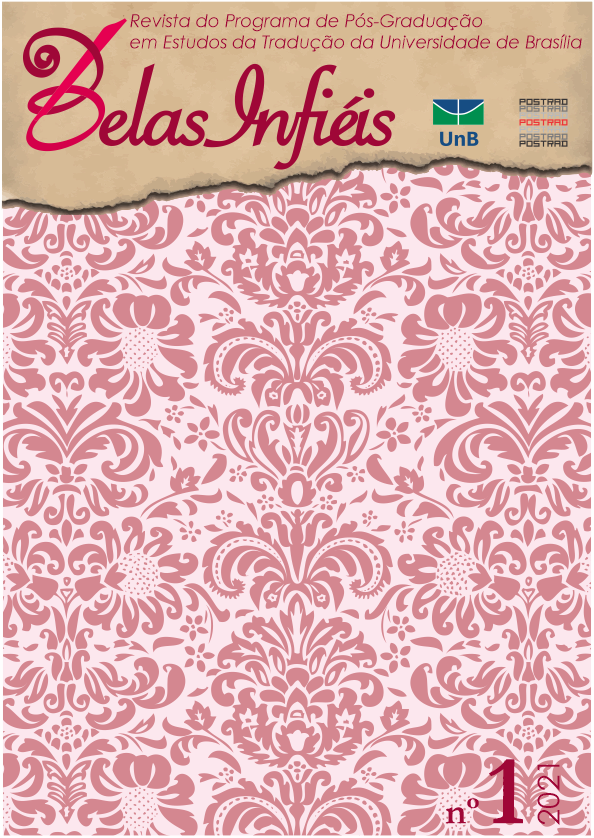Normative Analysis of Interpretation and Description on an Audio Description Script Translation
DOI:
https://doi.org/10.26512/belasinfieis.v10.n1.2021.32855Keywords:
Accessibility. Audio Description. Screen Translation. Description. Interpretation.Abstract
This work aims to address the translation of audio description scripts. We will approach the concept of audio description, the advantages and disadvantages of translating an audio descriptive script instead of creating and independent one for each language and the audio description guidelines found in the official norms of each country. More specifically, we will study the Spanish and the British guidelines in order to analyze the translation to English from an audio description script of a Spanish short film. We will demonstrate how a script can become closer to the British norm. We will also analize the translation of a script based on the source and target guidelines to notice the differences and resort to a specialized bibliography to understand the ways that audiodescription may take, more specifically in relation to the description and interpretation dichotomy. Thus, we will reflect on the importance of the consonance of audio description with the norms of the target country.
Downloads
References
Asociación Española de Normalización y Certificación. (2005). Norma UNE: 153020. Audiodescripción para personas com discapacidad visual. Requisitos para la audiodescripción y elaboración de audioguías. Madrid.
Alves, S. F., Pereira, T. V., & Teles, V. C. (2011). Propostas para um modelo brasileiro de audiodescrição para deficientes visuais. Tradução & Comunicação ”“ Revista Brasileira de Tradutores, (22), 9”“29.
Alves, S. F., & Teixeira, C. R. (2015). Audiodescrição para pessoas com deficiência visual: princípios sociais, técnicos e estéticos. In C. Santos, F. Lamberti, & C. Bessa (Org.), Tradução em Contextos Especializados (pp. 34-35). Verdana.
Barbosa, R. (2017). Uma proposta de tradução e outra de elaboração de roteiro de audiodescrição em português para a série animada Bojack Horseman [Monografia, Universidade Federal de Uberlândia].
Bourne, J., & Hurtado, C. J. (2007). From the visual to the verbal in two languages: a contrastive analysis of the audio description of The Hours in English and Spanish. In J. Díaz Cintas, P. Orero, & A. Remael (Org.), Media for All ”“ Subtitling for the Deaf, Audio Description, and Sign Language (pp. 175-187).
Caro, M. R. (2013). El Impacto Emocional de la Audiodescripción [Tese de doutorado. Universidad de Murcia].
Chmiel, A., & Mazur, I. (2012a). Audio Description Made to Measure: Reflections on Interpretation in AD Based on the Pear Tree Project Data. In A. Remael, P. Orero, & M. Carrol (Org.), Audiovisual Translation and media accessibility at crossroads. Media for All (pp. 173-188). Rodopi.
Chmiel, A.; & Mazur, I. (2012b). AD reception research: Some methodological considerations. In E. Perego (Org.), Emerging topics in translation: Audio description (pp. 57-80). Edizioni Università di Trieste.
Costa, L. (2013). Normas técnicas da audiodescrição nos Estados Unidos e na Europa e seus desdobramentos no Brasil: interpretação em foco. Revista Brasileira de Tradução Visual, (13), 1-24.
Costa, L. (2014). Audiodescrição em filmes: história, discussão conceitual e pesquisa de recepção [Tese de doutorado, PUC-Rio].
Deltell, L. (Diretor). (2003). Di algo [Curta-metragem]. Aristia Produciones.
Díaz Cintas, J. (2007). Traducción audiovisual y accesibilidad. In J. C. Hurtado (Org.), Traducción y accesibilidad. Subtitulación para sordos y audiodescripción para ciegos: nuevas modalidades de Traducción Audiovisual. Peter Lang.
Fryer, L. (2016). An introduction to audio description ”“ a practical guide. Routledge.
López Vera, J. F. (2006). Translating Audio Description Scripts: The Way Forward? ”“ Tentative First Stage Project Results. MuTra 2006 ”“ Audiovisual Translation Scenarios: Conference Proceedings. Saarland University.
Matamala, A., & Orero, P. (2007). Designing a course on audio description and defining the main competences of the future professional. Linguistica Antverpiensia, 6, 329-344.
Santiago Vigata, H. (2012). Descrição e interpretação: duas possibilidades do audiodescritor? Tradução e Comunicação ”“ Revista Brasileira de Tradutores, (25), 23-32.
Naves, S. B.; Mauch, C.; Alves, S. F.; Araújo, V. L. S. (Org.). (2016) Guia Para Produções Audiovisuais Acessíveis. Brasília: Secretaria do Audiovisual do Ministério da Cultura.
Vercauteren, G. (2007) Towards a European guideline for audio description In J. Díaz Cintas, P. Orero & A. Remael (Org.), Media for all: Subtitling for the Deaf, Audio Description, and Sign Language (pp. 139-149). Rodopi,
Referências on-line
Independent Television Commission. (2000). ITC Guidance on Standards for Audio Description. http://www.ofcom.org.uk/static/archive/itc/itc_publications/codes_guidance/audio_description/index.asp.html
Silva, F. T. S., Bona, V., Silva, A. N. A., Carvalho, I., & Silc, E. V. (2010). Reflexões sobre o pilar da áudio-descrição: “Descreva o que você vê” [online]. http://audiodescriptionworldwide.com/associados-da-inclusao/rbtv/reflexoes-sobre-o-pilar-da-a
Downloads
Published
How to Cite
Issue
Section
License
Copyright (c) 2021 CC BY

This work is licensed under a Creative Commons Attribution 4.0 International License.
Given the public access to this journal, the texts are free to use but requires the recognition of the original authorship and initial publication in this journal to be properly stated.
 The journal allows the use of works published for non-commercial purposes, including the right to submit the work to publicly accessible databases. Published contributions are the sole and exclusive responsibility of the author(s).Â



















